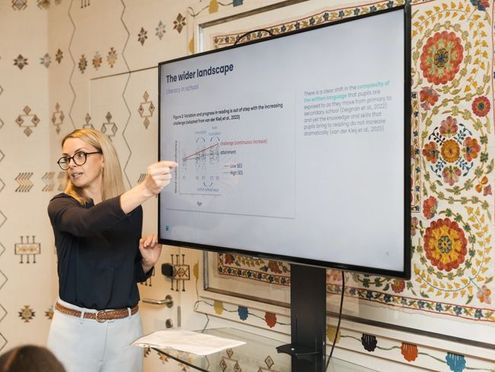What is the mastery approach?
The Education Endowment Foundation describes the mastery approach as “ensur[ing] that all pupils have mastered key concepts before moving on to the next topic”. They quantify mastery as being around 80% accuracy - this is the percentage for mastery in Bedrock’s core curriculum also.
In a classroom that does not feature the mastery approach, concepts are taught, practised and recapped, but there are no measures to ensure that every learner in the classroom is confident in the knowledge. Further than this, there is no means by which to test that learners have “overlearned” - meaning that learners have gone beyond an initial measure of mastery to an automatic recall of a skill or concept.
Without an approach that prioritises mastery, some learners may end up more confident using certain skills than others. This results in learners being left behind - and these learners, more often than not, fall into the demographics that make up the attainment gap.
Because of this, the mastery approach not only includes strategies that ensure learners master, and eventually overlearn, key concepts and skills, but also includes targeted support and scaffolding for learners who are struggling.
The mastery approach is especially effective for primary-age learners and STEM subjects such as maths and science.
Where did the mastery approach come from?
The first mention of the mastery approach for learning came from Bloom as early as 1968.
Bloom stated that at the time of his research piece, the average teacher believed only one-third of their cohort would understand the topic being taught adequately. Bloom introduced a concept that is now clear to most teachers - that “most students can master what we have to teach them”. Even from the first introduction of mastery as a concept, the focus was placed on the systems of teaching that keep disadvantaged learners held back from their potential. Accepting that some learners will just “get by” is not adequate - teachers must ensure that every learner has the tools they need to understand and master new concepts.
In 1988, Guskey and Pigott published a meta-analysis on the benefits of the mastery approach and found that in group-based applications, such as in the standard classroom, the mastery approach yielded “consistently positive effects on both cognitive and affective student learning outcomes” regardless of group size.
Despite having similar-sounding names, the mastery approach - or learning for mastery - is differentiated from a similar theory, teaching for mastery. Teaching for mastery focuses on a teacher-led, whole-class approach to ensuring learning is mastered, while the mastery approach uses differentiated instruction and targeted interventions to ensure every student has the knowledge they need to thrive. The EEF has done extensive research into the effectiveness of the mastery approach, but has not for the “teaching for mastery” theory, and therefore separates the two approaches from one another.
No matter the size or ability of your classroom, with the right scaffolding and support, all learners are capable of achieving mastery and hitting educational targets. Bloom stated that encouraging teachers to believe this of their students empowers them as educators, as well as empowering the learners themselves.
How does the mastery approach differ from standard teaching practices?
The mastery approach differs from standard teaching practices in the time it takes to implement. If a teacher or school is to focus on the mastery approach, multiple factors must be included, such as:
- Frequent diagnostic assessments with high targets (usually 80-90%)
- Scaffolded teaching that gradually builds on content over time
- Targeted interventions for learners who have not mastered certain concepts
- Assessments should be held before, during and after every topic to gain clear insights into the confidence level of every learner
Despite all of the above, teachers should also have flexibility in their curriculum to allow for more time to be spent on a concept should it not be mastered. At a time when teachers have less time than ever, implementing all of the crucial aspects of the mastery approach while remaining flexible can be a challenge.
The benefit of the mastery approach versus other teaching strategies is that teachers can pick and choose the time frame and topics where mastery is utilised. This could mean applying it across the whole curriculum for an entire academic year or just using it in a handful of subjects for just a half-term. The EEF’s findings suggest the mastery approach may be more effective in maths and science; these could be the subjects to focus on first when introducing mastery to your curriculum.
Elements of the mastery approach
Pre-assessment
To gauge learners’ mastery of a topic over time, teachers should begin every new topic with a pre-assessment. This gives teachers visibility on the prior knowledge of their learners.
Linking back to the attainment gap, teachers may see that learners from advantaged backgrounds have more prior knowledge of a topic, or find it easier to pick up aspects of the new topic through context. Having visibility of this attainment gap in pre-assessment results makes it easier to anticipate where additional support may be required.
Instruction
The mastery approach shifts the responsibility for learners’ attainment onto the quality of the instruction. Under this approach, every student is considered capable of achieving targets with the right support. Much like with the theory of scaffolding, teachers implementing the mastery approach spend more time in lessons actively instructing learners, modelling concepts, engaging in active conversation and addressing misconceptions.
As well as this, there is the dilemma of how to stretch high-achieving learners while supporting those who struggle. This means teachers must dedicate more time to lesson planning and instruction to achieve both goals - even if this means cutting back on other aspects of the lesson, such as completing worksheets.
Formative assessment
Lesson planning under the mastery approach is flexible and guided by the needs of the learners. This means that teachers must include frequent formative assessments in their lesson plans, helping to give insights as to whether learners are on track to mastery. If not, more time should be devoted to the elements they are struggling to understand.
Not only do formative assessments help teachers understand learners’ current understanding, but they also help teachers moderate their teaching, address misconceptions and make progress in their careers.
Corrective instruction
The purpose of formative assessments is to identify misconceptions. These misconceptions are then addressed through corrective instruction.
Now that the teacher understands the areas of difficulty learners are facing, the lesson plan can be altered to allow more time for the more tricky aspects of the lesson. This could include whole-class instruction for areas most learners don’t understand, or targeted support for specific learners who struggle with aspects of the teaching.
Teachers, while introducing corrective instruction, should ensure that reteaching content does not slow down or bore learners who understood the first time - corrective instruction should support and boost learners’ progress, no matter their prior ability.
Summative assessment
Summative assessments should be held at the end of topics to check whether or not learners have achieved mastery. With the previous steps implemented correctly, learners should be earning a score of 80% (or higher) on their summative assessment, indicating mastery. However, if learners do not achieve this, this summative assessment serves to indicate where learners need additional support.
The mastery approach is flexible: time should be factored in to support learners who have not achieved mastery in the summative assessment. This ensures that learners who do not master the material as quickly as others are not “left behind”.
How does the mastery approach work in literacy?
Mastery in reading
Indicators of mastery in reading involve delving deeper into the subtextual implications of word choice. For example, understanding that the words “gave” and “thrust” have different implications, while recognising that these affect the emotions within a text.
Learners demonstrating mastery in reading also understand that the authors have made deliberate choices when writing a text, and can delve deeper into what these choices mean and their intentions.
Mastery in writing
Mastery in writing is demonstrated through learners having a deep, layered understanding of the English language. Not only does this involve having the skills to craft a narrative and communicate well, but it also involves having a rich vocabulary - without the right words in their arsenal, no learner can demonstrate a mastery of writing. No matter the prior ability of your learners, an explicit vocabulary curriculum gives all learners more and more tools with which to communicate effectively - and thus develop mastery of writing.
Learn more about mastery in writing and how it can be achieved.
The benefits of mastery learning
1. Learners aren't "left behind" by too-quick teaching
Research into the attainment gap shows that a learner’s literacy level at the age of five, as well as their socioeconomic background, has implications on their attainment throughout their lives. For this reason, leaving vocabulary and reading as skills to be acquired incidentally “leaves behind” learners from disadvantaged backgrounds.
The mastery approach prioritises the explicit teaching of all areas of a topic, no matter the discipline; this includes the Tier 2 and 3 vocabulary learners need to engage with a complex academic text.
2. The mastery approach inspires a love of learning
Despite the use of consistent assessments throughout a topic, the mastery approach aims to change attitudes around testing. Rather than test results being an indicator of failure to the learner, they are instead viewed as a means to visualise what additional support is needed. Low results are not a mark against the student but a tool for teachers to use to drive the effectiveness of their lessons. This helps to reduce the anxiety and competitiveness around assessments.
3. Mastery allows for individualised teaching
Gaining visibility over areas learners are struggling with through consistent assessment allows teachers to individualise instruction. Learners who need additional support are identified and misconceptions are addressed.
Additionally, teachers have the freedom to prioritise their time and retain flexibility in their lesson plans, allowing them to stretch high-achieving learners and scaffold struggling learners. Supported by digital literacy tools that promote mastery, such as Bedrock’s core curriculum and Bedrock Mapper, teachers can spend time on personalised instruction rather than marking.
Setting up mastery teaching in your school
Focusing on vocabulary
One of the simplest steps your school can take towards mastery is prioritising vocabulary instruction in every subject. Pre-teaching the vocabulary learners need in every subject gives them the tools to access complex academic texts and communicate like experts across the curriculum. Implementing an explicit vocabulary strategy that encompasses Tier 2 and Tier 3 vocabulary not only supports the mastery approach but boosts your learners’ attainment.
Reprioritising teachers’ time
Implementing the mastery approach is a time-consuming process. With teachers’ time more limited than ever, it can seem like an impossible task to find room for flexibility and mastery in content-rich lessons.
To create space for the mastery approach in your lessons (and reap the benefits), time must be taken away from tasks such as marking and put towards explicit instruction in the classroom. As well as promoting the mastery approach, some digital tools, such as Bedrock’s literacy curricula, are self-marking, giving you back time to spend doing what you’re passionate about: teaching.
Understanding mastery for parents and families
Parents and guardians play a crucial role in supporting their children’s academic success. For this reason, it’s worthwhile for any school on a mastery journey to include parents in the process.
To help parents and guardians understand the mastery approach and how they can support their child’s mastery, we expand on the mastery approach for parents and families.
How Bedrock uses the mastery approach
Bedrock’s digital literacy curricula are based on the fundamentals of the mastery approach. Not only do Bedrock’s curricula prioritise explicit vocabulary and grammar instruction, giving learners the tools to achieve mastery in every subject, but markers of success on Bedrock are aligned to mastery. For example, a learner has achieved mastery with Bedrock’s grammar curriculum when they achieve a score of 80% after several recap activities - with this structure, Bedrock’s core curriculum incorporates the formative and summative assessment structure of the mastery approach.
This is developed further with the implementation of Bedrock Mapper, Bedrock’s bespoke Tier 3 vocabulary tool. Bedrock Mapper allows teachers of all subjects to access over 22,000 Tier 3 terms across 19 subjects, including over 100,000 disciplinary literacy activities.
Through Mapper, teachers in every subject can contribute to the development of a mastery approach across the school.




